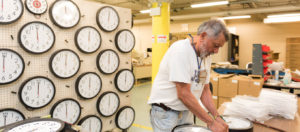#Fun4theDisabled explores the history of the Chicago Lighthouse and details their services for the visually impaired and beyond.
Transcript with visual descriptions:
[Uplifting music plays throughout the video.]
Text on screen reads: For more information and a full transcript of this video, check out Fun4thedisabled.com.
[Image on screen: A close up of The Chicago Lighthouse logo.]
[Image on screen: A teacher works with adult students at a table.]
[Image on screen: A young child in daycare smiling as an adult helps them put on their jacket while other children play in the background.]
[Image on screen: A doctor adjusts the glasses of a patient during an eye exam.]
[Image on screen: The exterior of the The Chicago Lighthouse building, with their sign above the doorway.]
Narrator and text on screen: Serving the blind, seeing impaired, and a variety of other disabilities, as well as veterans,
[Image on screen: A teacher is works with a student learning how to type on a braille typewriter.]
Narrator and text on screen: The Chicago Lighthouse for the Blind has been working in vision care, rehabilitation, education, employment and technology for over 100 years.
[Image on screen: A receptionist sits, smiling, at the front desk of The Chicago Lighthouse.]
Narrator and text on screen: Founded in 1906 on the city’s West Side, and originally named the Improvement Association for Blind People,
[Image on screen: Outside The Chicago Lighthouse, a group of people walk out.]
Narrator and text on screen: Early activities included collecting donated food and clothing, as well as teaching employable skills such as weaving and carpentry.
[Image on screen: A person works at a call center computer as their instructor observes.]
Narrator and text on screen: In the late ‘70s, The Lighthouse secured the contract for one of its most iconic programs,
[Image on screen: A call center employee smiles, looking at the camera from their desk.]
Narrator and text on screen: the exclusive manufacturing of clocks for the federal government, a program that thrives to this day.

Image shows client putting together clock in his workspace with 18 wall clocks behind him on the wall.
[Image on screen: Governor Pritzker shakes the hand of a worker as he receives a clock.]
Narrator and text on screen: Since its founding, The Lighthouse has grown its capacity and services,
[Image on screen: A teacher presents their seated student a coat in the classroom.]
Narrator and text on screen: expanding its mission to include a wider array of disabilities, and a demographic in need, veterans
[Image on screen: The board of The Chicago Lighthouse present Senator Durbin with a clock in front of a The Chicago Lighthouse logo.]
Narrator and text on screen: Today, The Lighthouse offers 39 different programs and services in the categories of
[Image on screen: Young students around a table learn how to operate braille typewriters from their teacher.]
Narrator and text on screen: Vision Care, Independent Living, Employment and Training, Assistive Technology, Education, and Social Enterprise
[Image on screen: A person uses a vision assistance device on their glasses during a meeting.]
Narrator and text on screen: These range from classes in which visually impaired and sighted students learn together in the same classroom
[Image on screen: A group of daycare students and their teachers in their classroom smile at the camera.]
Narrator and text on screen: To world-class doctors that work to maximize their patients’ remaining vision
[Image on screen: A doctor holds up a reading card as a part of a patient’s vision test.]
Narrator and text on screen: To training programs for office and customer service skills.
[Image on screen: A person is providing instruction to another, as they sit at cubicles.]
Narrator and text on screen: The Lighthouse also employs people directly through Chicago Lighthouse Industries and Customer Care Centers
[Image on screen: A person sits at a computer asking a question to their instructor, who stands over them.]
Narrator and text on screen: At Chicago Lighthouse Industries, employees are provided job training and produce consumer products
[Image on screen: A person assembles a clock as they stand next to a wall covered in clocks.]
Narrator and text on screen: such as clocks and calendars for federal, municipal and commercial customers
[Image on screen: Mayor Lightfoot, receives a clock.]
Narrator and text on screen: The Customer Care Centers employ more than 600 people, offer job training,
[Image on screen: An employee of a call center smiles to the camera while sitting at their desk, as their instructor stands over them.]
Narrator and text on screen: and provide call center services for clients such as the Illinois Tollway Authority.
[Image on screen: An employee of a call center smiles to the camera while sitting at their desk as other employees work at their stations.]
Narrator and text on screen: Serving more than 67,000 people each year,
[Image on screen: A person plays drums and sings on an outdoor stage.]
Narrator and text on screen: The Chicago Lighthouse for the Blind is committed to access and inclusion for people with disabilities.
[Image on screen: A group of people, one with a guide dog, walk towards the camera and into the entrance of The Chicago Lighthouse.]
Narrator and text on screen: To learn more about all their services, how you can get involved, or how you can donate, go to chicagolighthouse.org or call 312-666-1331
[Image on screen: The exterior of The Chicago Lighthouse building.]
Text on screen reads:
Directed by Vanessa A. Harris
Script, Narration and Editing by Cameron Petti
Music by Antarctic “Inspirational and Happy Time”
Thank you again to The Chicago Lighthouse
[Image on screen: A close up of The Chicago Lighthouse logo.]

Recent Comments